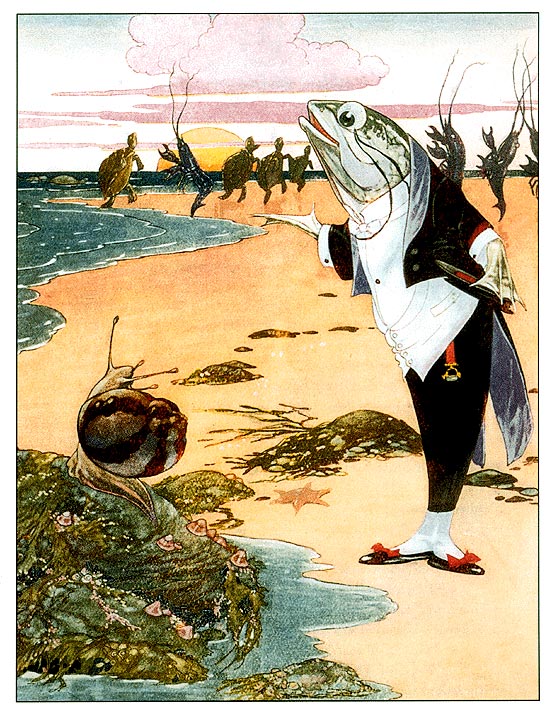'Teddy Tail'.
Charles James Folkard was a British book illustrator and comic artist. He is best remembered as the creator of 'Teddy Tail' (1915-1926), one of the earliest and longest-running British newspaper comics, appearing in The Daily Mail. 'Teddy Tail' holds further historical significance as one of the earliest British "funny animal" comics, along with Julius Stafford Baker's 'Tiger Tim and the Bruin Boys' (1904-1985). It was also one of the first British comics to feature speech balloons.
Early life and career
Charles Folkard was born in 1878 in Lewisham, London, as the son of a merchant's clerk. His older brother was cartoonist Harry Folkard. Charles attended St. John's Wood School of Art, and for a short time took evening classes at Goldsmith's College School of Art, but otherwise was mostly self-taught as an artist. Prior to his graphic career, he worked as a magician and conjuror, performing under the name Professor Volkart at charity shows, children's parties and concerts. While designing his own programmes, Folkard realized that his greater talent was in drawing in the "old boys" magazine of his former school, the Colfe's School in Lewisham. Among the main inspirations for his art were the illustrators Arthur Rackham and Edmund Dulac
Book illustrator
Charles Folkard's career in illustration kicked off when magazines like Little Folks and the Tatler published his illustrations. By 1907, he was working on the artists staff of the Amalgamated Press, publisher of newspapers like the Daily Mail. With his illustrations for Johann David Wyss' classic novel 'The Swiss Family Robinson' in 1910, Folkard finally got noticed. Soon after, he was asked to liven up the pages of other classic novels, fairy tales and fables, including Carlo Collodi's 'Pinocchio' (1910), 'The Children's Shakespeare' (1910), 'Grimm's Fairy Tales' (1910), 'Aesop's Fables' (1912), 'Arabian Nights' (1913), 'The Jackdaw of Rheims' (1913), 'Ottoman Wonder Tales' (1915), 'Mother Goose' Nursery Rhymes' (1919), 'British Fairy and Folk Tales' (1920), 'Alice in Wonderland and Alice Through the Looking-Glass' (1921), 'The Magic Egg' (1922), 'The Troubles of a Gnome' (1922) and 'The Land of Nursery Rhyme' (1932). Most of these books were published by A & C Black and later Dent's Children's Illustrated Classics.
'Songs From Alice in Wonderland and Through the Looking Glass', illustrated by Charles James Folkard and set to music by Lucy E. Broadwood.
Teddy Tail
In 1915, the editor of the Daily Mail asked Folkard to create a daily picture story for the newspaper. On 5 April 1915, the paper ran the first episode of 'Teddy Tail', a daily comic strip about an anthropomorphic mouse with a huge bow tie, short jacket and cherry nose, published in the newspaper The Daily Mail. The character was named after the cartoonist's son, Edward (Ted) Folkard. In his first adventure, Teddy's companion's Dr. Beetle fell down a crack in the floorboards, and in order to rescue him, Teddy tied a knot in his tail and lowered it, hoping that his friend could get a firm grip. He did, but unhappily the knot would never come undone, and so Teddy Tail had to wear it forever. All stories take place in a forest, where Teddy's friends live, among them: Dr. Beetle, the Penny Princess, Golliwog and Snail. The narratives are usually based on fairy tales, children's nursery rhymes and occasionally on historical events.
In a 1992 historical book about the Folkard family, the following is written about Charles Folkard's working methods: "Having brought a picture to what seemed like perfection he would consider it, then often discard it and start again. Charles did not use models directly but would make sketches of his own family and local children. His son Edward was the inspiration for Teddy Tail, his daughter Betty for Teddy's companion Dr Beetle, and Janet, the other daughter, was the Curly niece."
'Teddy Tail' is often credited with popularizing British newspaper comics. The stories were so successful that they were made available in book format and children's annuals. They inspired toys, biscuits, jigsaw puzzles, books, Christmas annuals, a 1920 musical play and even an official fan club, The Teddy Tail League (1933). Soon, the Daily Mail made room for more comics, while other British newspapers also started running them. Many tried to mimic 'Teddy Tail' by also making comics starring funny animals, such as Bertram Lamb and Austin Bowen Payne's 'Pip, Squeak and Wilfred' (1919-1956) and Mary Tourtel's 'Rupert Bear' (1920).
'Teddy Tail' also ran in the US newspaper The Detroit Free Press in 1919.
During World War I, Charles Folkard enlisted in the Artists' Rifles, leaving the 'Teddy Tail' to his brother Harry for the first time. However, he was invalided out of the Army, and quickly took over the reins again. By 1926, Charles Folkard Folkard left his charming comic series to focus on his illustration work. In April 1933, the comic was revived as a color page in the Mail's kids supplement by his brother Harry Folkard, who gave the mouse the age of a schoolboy. In November of that year, 'Teddy Tail' was taken over by Herbert Sydney Foxwell, whose run is characterized by several new cast members, such as Mrs. Whisker the mouse, Piggy the pig, Kitty Puss the cat and Dougie the duck. During World War II, Foxwell was drafted into military service and died in 1943. In 1945, 'Teddy Tail' was resurrected once again by subsequent illustrators like Arthur Potts and William St. John Glenn. The character was given another makeover and now looked more like a typical animated cartoon character from that era. His adventures continued until 1962.
Theater work
In his spare time, Charles Folkard painted scenery for the Eltham Dramatic Society, produced and wrote a pantomime and gave shadow plays behind a screen. Another interest was renovating antique furniture, for which he skillfully carved replacement parts. In 1920, he carved puppets for a 'Punch and Judy' show, which toured round the children's hospitals. In the same year, the play 'Teddy Tail's Adventures in Fairy-land' was performed at the Duke of York's Theatre. Charles Folkard wrote the play, designed the costumes and the scenery. The music was by Frederick Norton of Chu Chin Chow fame, and the princess was played by Iris Hoey, a well-known soubrette of the day. The puppets are now in the collection of the Toy Museum in Edinburgh.
Final years and death
After leaving the comics medium, Charles James Folkard concentrated on book illustration for the rest of his career. He passed away in Heathfield, Sussex, on 26 February 1963. During the 1970s, some of Charles Folkard's illustrations were brought out as Christmas cards, and in 1978 'Songs of Alice', with his pictures and music by Don Harper, was published by Adam and Charles Black.
The artist's son Edward Charles Napier Folkard (1911-2005), who inspired the name of the Teddy Tail character, also went to Art School. He did freelance work until 1939 and was at one time tutor at the Royal College of Art and a regular exhibitor at the Royal Academy.
'Songs From Alice in Wonderland and Through the Looking Glass', illustrated by Charles James Folkard and set to music by Lucy E. Broadwood.







